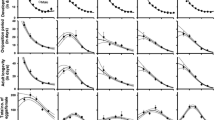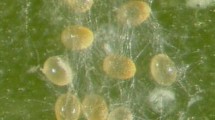Summary
Life history and resource utilization pattern were compared between two closely related mite species of the genusTetranychus.
-
1.
Tetranychus urticae developed more quickly and had a higher oviposition rate thanT. kanzawai. Consequently, the potential for population increase was greater forT. urticae than forT. kanzawai but the difference was slight.
-
2.
T. urticae was more tolerant of a deteriorating food resource and/or over-crowding.T. kanzawai responded more sensitively to food deterioration and dispersed more quickly.
-
3.
There was a considerable difference between injury patterns by the two species.T. kanzawai damaged host plants more severely, causing earlier and more extensive defoliation of the plants.
-
4.
The maximum population size achieved byT. urticae was 2 to 3 times greater than that ofT. kanzawai on potted host plant. This showed that the former could utilize a food resource much more efficiently.
Similar content being viewed by others
References
Herbert, H. J. (1981) Biology, life tables, and innate capacity for increase of the twospotted spider mite,Tetranychus urticae (Acarina: Tetranychidae).Can. Entomol. 113: 371–378.
Iwao, S. (1968) A new regression method for analyzing the aggregation pattern of animal populations.Res. Popul. Ecol. 10: 1–20.
Laing, J. E. (1969) Life history and life table ofTetranychus urticae Koch.Acarologia 11: 32–42.
Mothes, U. andK. A. Seitz (1982) Fine structural alterations of bean plant leaves by feeding injury ofTetranychus urticae Koch (Acari, Tetranychidae).Acarologia 23: 149–157.
Osakabe, M. (1967) Biological studies on the tea red spider mite,Tetranychus kanzawai Kishida in tea plantation.Bul. Tea Res. Sta. Min. Agr. For. 4: 35–156 (in Japanese with an English summary).
Saito, Y. (1979) Comparative studies of life histories of three species of spider mites (Acarina: Tetranychidae).Appl. Ent. Zool. 14: 83–94.
Southwood, T. R. E. (1977) Habitat, the templet for ecological strategies?J. Anim. Ecol. 46: 337–365.
Stearns, S. C. (1976) Life history tactics: A review of ideas.Quart. Rev. Biol. 51: 3–47.
Takafuji, A., T. Maeda, Y. Egashira, N. Morimoto andT. Henmi (1982) Spider mite fauna in pear and peach orchards in Okayama.Odôkon-Chûgoku 24: 9–12 (in Japanese).
Takafuji, A. andM. Kamibayashi (1984) Life cycle of a non-diapausing population of the two-spotted spider mite,Tetranychus urticae Koch in a pear orchard.Res. Popul. Ecol. 26: 113–123.
Uchida, M. (1980) Distribution of three species mites on pear orchards in Tottori district (Acarina: Tetranychidae).Odôkon-Chûgoku 22: 50–53 (in Japanese).
Wanibuchi, K. andY. Saito (1983) The process of population increase and patterns of resource utilization of two spider mites,Oligonychus ununguis (Jacobi) andPanonychus citri (McGregor), under experimental conditions (Acari: Tetranychidae).Res. Popul. Ecol. 25: 116–129.
Author information
Authors and Affiliations
Rights and permissions
About this article
Cite this article
Kondo, A., Takafuji, A. Resource utilization pattern of two species of tetranychid mites (Acarina: Tetranychidae). Res Popul Ecol 27, 145–157 (1985). https://doi.org/10.1007/BF02515487
Issue Date:
DOI: https://doi.org/10.1007/BF02515487




